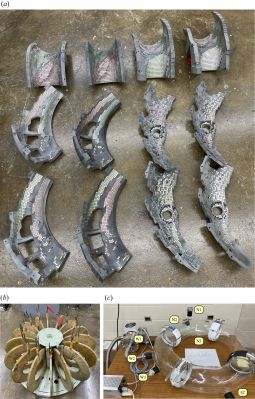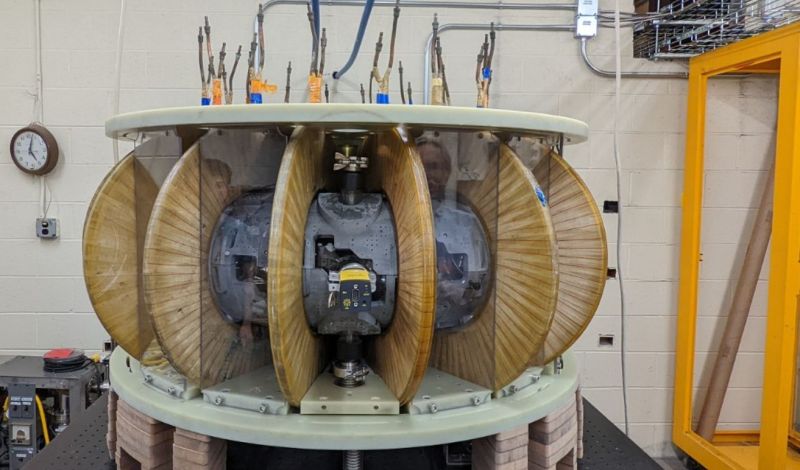
When you think of a fusion reactor like a tokamak or stellarator, you are likely to think of expensive projects requiring expensive electromagnets made out of exotic alloys, whether superconducting or not. The MUSE stellarator is an interesting study in how to take things completely in the opposite direction. Its design and construction is described in a 2023 paper by [T.M. Qian] and colleagues in the Journal of Plasma Physics. The theory is detailed in a 2020 Physical Review Letters paper by [P. Helander] and colleagues. As the head of the Stellarator Theory at the Max Planck Institute, [P. Helander] is well-acquainted with the world’s most advanced stellarator: Wendelstein 7-X.
As noted in the paper by [P. Helander] et al., the use of permanent magnets can substantially simplify the magnetic-field coils of a stellarator, which are then primarily used for the toroidal magnetic flux. This simplification is reflected in the design of MUSE, as it only has a limited number of identical toroidal field coils, with the vacuum vessel surrounded by 3D printed structures that have permanent magnets embedded in them. These magnets follow a pattern that helps to shape the plasma inside the vacuum vessel, while not requiring a power supply or (at least theoretically) cooling.
Naturally, as noted by [P. Helander] et al, a limitation of permanent magnets is their limited field strength, inability to be tuned, and demagnetization at high temperatures. This may limit the number of practical applications of this approach, but researchers at Princeton Plasma Physics Laboratory (PPPL) recently announced in a self-congratulatory article that they will ‘soon’ commence actual plasma experiments with MUSE. The lack of (cooled) divertors will of course limit the experiments that MUSE can be used for.
















Miniaturized further it could be used as a ski boot heater!
Its not clear from the article whether the design has been tested and found to work as expected yet.
Go on. Let’s make the arc reactor in the end with cave style.
How and what is the possibility that these (PM) permanent magnets will NOT lost it’s magnetic fields flux when and during the handling of hot fusion plasma millions degrees and when converting the fusion energy to electricity indirectly or directly ? TY !, By FMSJR. (22-April-2024)
I want to know more about the “Glass ports were hot welded to the torus.” part.
Well, this device seems quite useless, although I’m no fusion engineer. How many more toy reactors do we need?
Economy model, if at all functional would be interesting. 6 million dollar device, hits breakeven because you don’t have to spend energy to energize as many coils, could be a stepping stone to a usable lower budget fusion power Device.
“How many more toy reactors do we need?”
I see it as a teaching aid.
same reason people still build fusors. also cheap neutron sources.
though i doubt this torus is that useful.
At least one more. My office could use a coffee table.
There’s always a ton of confusion about this. These aren’t fusion research devices. They’re not reactors, they’re not trying to produce fusion. They’re plasma research devices. Plasma research is *used* in fusion research, but the point here is not to create power, it’s to understand the plasma dynamics and the control methods. Magnetohydrodynamics is a Hard Problem.
The point of investigating permanent magnets in this setup is that normally a stellarator has a complex field geometry that needs to be produced by superconductors: but obviously magnetic fields are additive, so there’s no reason you can’t have *part* of the field be supplied by a permanent magnet and the rest by superconductors if it simplifies the overall geometry.
Basically you can imagine the permanent magnets acting like tuning mechanisms which could be physically adjusted to deal with imperfections, or to simplify the geometry of the superconducting coils.
Model trains are useless. How many more toy trains do we need?
I don’t care. I’m building one in my apartment.
If you see a blue plasma cloud a rockin, don’t come a knockin.
don’t irradiate your neighbors.
If they were to use fabrisonic for their 3d printing, they could print cooling channels without the “sandy” surface finish on the interior. Solid state welding – its a very cool technology. Then they could have cooling along with embedded magnets.
Serious question, just how small can a stellarator/tokamak be made? Are the massive experiments we see with the most recent reactors that large because that’s as small as we can make the containment magnets? Is it possible to get a plasma loop small enough to fit into something the size of a residential microwave?
Thermal regulation might get tricky (among other things)
I don’t think the magnets are the reason. It’s pretty easy to build small fusion reactors, the challenge is to make one that produces more energy than it consumes. Which is where scale becomes important. I’m guessing a larger size is easier to keep hot enough because it has more volume relative to surface area. And there are probably other scaling effects that lead to better efficiencies at larger scale.
If all you’re interested in is generating a confined plasma, sure, you can make them very small, but plasma won’t get very hot. You can deal with that by increasing the field strength, but the amount you have to increase the field strength by means that the overall device just grows anyway due to physical engineering considerations.
I wouldn’t actually even consider the current experiments “massive” – definitely not massive from a power-plant perspective, and not even really from a physics perspective. Even the reactor-scale projects are like 15-20 meter diameter for GW-scale production, which isn’t very big at all.
Larger devices are relatively “straighter”, there’s less of a curve for the particles to go around.
“This could be us but you won’t summon Zool.”
I was just about to note that of course the lack of (cooled) divertors will be a limiting factor for the experiments that MUSE can be used for, but I see somebody already foresaw that concern and added a note at the end of the article.
fusion reactors are complex and have a lot of subsystems to test, preferably in isolation. this is where test articles like this come into play. its not just:
build a reactor
???
profit
its more like “i have a specific thing i want to test, how can i do that without building a multi billion dollar machine?” or, how to best utilize my limited grant money.
If they added parallel magnetic paths, they could use small coils and single short pulses of electricity to switch the flux from the permanent magnets and dynamically control the plasma with much lower input power.